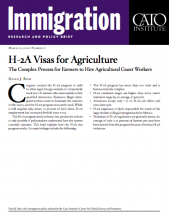H‑2A Visas for Agriculture: The Complex Process for Farmers to Hire Agricultural Guest Workers
Congress created the H‑2A program in 1986 to allow legal foreign workers to temporarily work for U.S. farmers who were unable to hire qualified Americans. However, illegal immigrant workers came to dominate the industry in the 1990s, and the H‑2A program was rarely used. While it still supplies only about 10 percent of farm labor, H‑2A employment has increased fivefold since 2005.
The H-2A program needs reforms, but productive reform is only possible if policymakers understand how the system currently operates. This brief explains how the H-2A visa program works. Its main findings include the following:
- The H-2A program has more than 200 rules and is bureaucratically complex.
- H-2A minimum wages are higher than every state’s minimum wage by, on average, 57 percent.
- Americans accept only 1 in 20 H-2A job offers, and most later quit.
- H-2A expansion is likely responsible for much of the large decline in illegal immigration from Mexico.
- Violations of H-2A regulations are generally minor. An average of only 0.27 percent of farmers per year have been barred from the program because of serious H-2A violations.
Bier, D. (2020, March 10). H‑2A visas for agriculture: The complex process for farmers to hire agricultural guest workers (Research and Policy Brief 17). Cato Institute. https://www.cato.org/publications/immigration-research-policy-brief/h-2a-visas-agriculture-complex-process-farmers-hire

